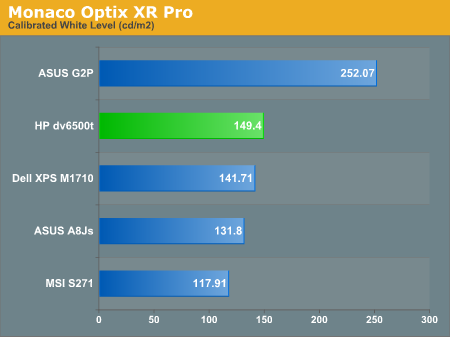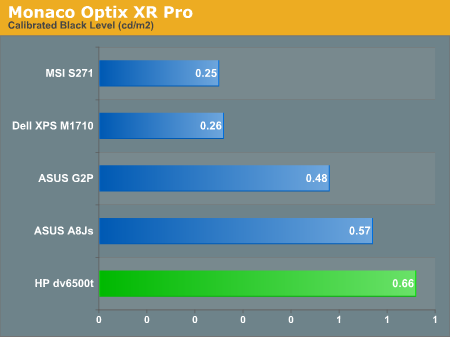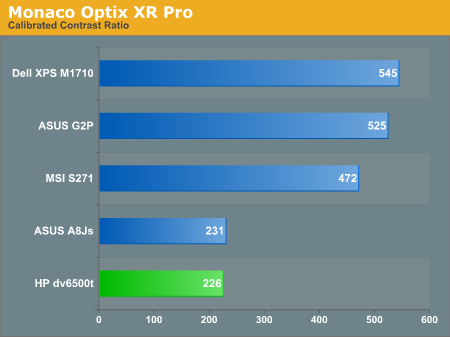LCD Brightness, Contrast, and Viewing Angles
We recently did an article taking a closer look at the LCD panels on several laptops, and all of our future of laptop reviews will include coverage of this important feature. Our testing methodology is the same as we use in our desktop LCD reviews, although somewhat more limited in scope. The simple truth is that even the best laptop LCDs tend to pale in comparison to typical desktop LCDs. One of the reasons for this can be found by examining the panel used in the HP dv6500t notebook.
Using a utility called ASTRA32, we discovered that the LCD panel is an AU Optronics model AUO 2174 (though we admit that ASTRA32 could make mistakes). While that model number may not mean much to most people, perhaps more telling is the manufacture date of January 2005. This is a brand new notebook based on Intel's just-released Santa Rosa platform, and yet the LCD is apparently about 2.5 years old! Needless to say, LCD technology has advanced quite a bit in the past couple of years.
Our initial impression of the LCD panel prior to getting the above information was that it was pretty average at best. It's not particularly bright, viewing angles are limited (like most other TN panels), and colors seemed a bit off. All of these are characteristics that we would expect to find in LCDs from several years ago, but we ran through the rest of our tests regardless. Sadly, we would wager that HP isn't the only company using older LCDs on their laptops.
We'll start with a quick look at brightness and contrast ratios, then we'll look at viewing angles, and we'll conclude our examination of the LCD by looking at the color accuracy, before and after hardware calibration. For color accuracy, we are also including results using ColorEyes Display Pro in addition to Monaco Optix XR Pro. One of our readers pointed out that Monaco Optix XR Pro uses the older ICCv2 profile specification and that it might not be as accurate as software that uses the more recent ICCv4 specification. We still use the Monaco Optix XR Pro colorimeter (which is the same as the DTP-94) with both applications, and in general we did find that ColorEyes Display Pro produces better results on laptops. However, on at least a couple of displays we've tested, the results are better with Monaco Optix XR Pro, so we will continue to use both applications.



The white level is pretty typical of most laptop LCDs, maxing out at around 150 nits; black levels however are not very good, coming in at 0.66 nits -- the brightest "black" of any of the tested LCDs. The net result is one of the lowest contrast ratios we've measured. Subjectively, we would agree with the measurements: the overall quality of the LCD panel is slightly better than the panel on the ASUS A8Js, but we wouldn't rate it better than any of the other LCDs.
Brightness and contrast ratios aren't necessarily the most important aspect of a display, so let's move on to the other areas. Here's a look at the viewing angles, taken at 30° from center. Images for the other laptops can be viewed at the following links:
ASUS A8Js
ASUS G2P
Dell M1710
MSI S271
The lackluster LCD performance continues, with viewing angles that are no better -- and often worse -- than any of the other LCDs. During typical use of the notebook, it's not uncommon to find that you need to adjust the screen in order to properly see things. Even a small movement of your lap can mean the difference between an okay viewing angle and one that washes all of the colors out. Since all of these notebooks so far use TN panels, the somewhat limited viewing angles aren't too surprising. We are still trying to get some laptops in for testing that use IPS panels, as those are likely to perform better.
We recently did an article taking a closer look at the LCD panels on several laptops, and all of our future of laptop reviews will include coverage of this important feature. Our testing methodology is the same as we use in our desktop LCD reviews, although somewhat more limited in scope. The simple truth is that even the best laptop LCDs tend to pale in comparison to typical desktop LCDs. One of the reasons for this can be found by examining the panel used in the HP dv6500t notebook.
Using a utility called ASTRA32, we discovered that the LCD panel is an AU Optronics model AUO 2174 (though we admit that ASTRA32 could make mistakes). While that model number may not mean much to most people, perhaps more telling is the manufacture date of January 2005. This is a brand new notebook based on Intel's just-released Santa Rosa platform, and yet the LCD is apparently about 2.5 years old! Needless to say, LCD technology has advanced quite a bit in the past couple of years.
Our initial impression of the LCD panel prior to getting the above information was that it was pretty average at best. It's not particularly bright, viewing angles are limited (like most other TN panels), and colors seemed a bit off. All of these are characteristics that we would expect to find in LCDs from several years ago, but we ran through the rest of our tests regardless. Sadly, we would wager that HP isn't the only company using older LCDs on their laptops.
We'll start with a quick look at brightness and contrast ratios, then we'll look at viewing angles, and we'll conclude our examination of the LCD by looking at the color accuracy, before and after hardware calibration. For color accuracy, we are also including results using ColorEyes Display Pro in addition to Monaco Optix XR Pro. One of our readers pointed out that Monaco Optix XR Pro uses the older ICCv2 profile specification and that it might not be as accurate as software that uses the more recent ICCv4 specification. We still use the Monaco Optix XR Pro colorimeter (which is the same as the DTP-94) with both applications, and in general we did find that ColorEyes Display Pro produces better results on laptops. However, on at least a couple of displays we've tested, the results are better with Monaco Optix XR Pro, so we will continue to use both applications.



The white level is pretty typical of most laptop LCDs, maxing out at around 150 nits; black levels however are not very good, coming in at 0.66 nits -- the brightest "black" of any of the tested LCDs. The net result is one of the lowest contrast ratios we've measured. Subjectively, we would agree with the measurements: the overall quality of the LCD panel is slightly better than the panel on the ASUS A8Js, but we wouldn't rate it better than any of the other LCDs.
Brightness and contrast ratios aren't necessarily the most important aspect of a display, so let's move on to the other areas. Here's a look at the viewing angles, taken at 30° from center. Images for the other laptops can be viewed at the following links:
ASUS A8Js
ASUS G2P
Dell M1710
MSI S271
 |
The lackluster LCD performance continues, with viewing angles that are no better -- and often worse -- than any of the other LCDs. During typical use of the notebook, it's not uncommon to find that you need to adjust the screen in order to properly see things. Even a small movement of your lap can mean the difference between an okay viewing angle and one that washes all of the colors out. Since all of these notebooks so far use TN panels, the somewhat limited viewing angles aren't too surprising. We are still trying to get some laptops in for testing that use IPS panels, as those are likely to perform better.










26 Comments
View All Comments
Procurion - Sunday, June 24, 2007 - link
Having bought a Sager after a LOT of research(and an RMA'd Ferrari-Acer, lol, not the car) I question the quest for extreme resolution. My laptop has a native 1900x1200 screen which I consider unuseable on a 17" screen....1024x768 puts a LOT of info on screens and I wonder why the preoccupation with "ultra resolution"? If this is a casual use/business use type of laptop, those high rez settings aren't necessary at all. Either that or my 40-something bespectacled eyes just ain't cuttin' it anymore...:)strikeback03 - Monday, June 25, 2007 - link
Personally, I consider 1024x768 the bare minimum - I can't fit as much on the screen as I like. My Thinkpad has a 1400x1050 15" screen that I consider about perfect. As mentioned, the good thing is that both 1024x768 and 1600x1200 are available in the same screen size.On a side note, Lenovo still has T60s with Flexview IPS screens - we just bought one for work. They might not want to send one out for review though as word has it that the T61 will not be available with Flexview and will be hard to get with a 4:3 ration screen at all.
JarredWalton - Sunday, June 24, 2007 - link
I don't have a huge problem with the resolution - it's *okay* - but it would be nice to have options. Regardless, the quality of the display is not at all good compared to a lot of other recent laptops. Ideally, users should be able to choose from more than one screen config, but that's often limited to more expensive notebook models. Running Windows Vista, I feel 1280x800 is cramped, 1440x900 is passable, and 1680x1050 given enough room to make me happy. Then again, I run a 30" desktop LCD at 2560x1600.... :)Procurion - Monday, June 25, 2007 - link
Point taken about the need for some options rather than "one size fits all"-as a matter of fact my post was inspired because my needs/resolutions are different than, say, yours. As you and several other authors here have pointed out in the past, for the costs involved it is beyond me why the manufacturers put some really awful screens out there on their laptops....After opening a laptop up and booting it, what is the first thing that makes an impression? And you have to look at it every time you use the damn thing? LOL...legoman666 - Saturday, June 23, 2007 - link
You know... you could get rid of all the problems with your benchmarking programs not working on Vista by simply uninstalling it and installing Windows XP instead. My sister (not a big computer person) just bought a new laptop. The FIRST thing she and I did when it arrived was uninstall Vista and put XP on it.JarredWalton - Saturday, June 23, 2007 - link
Which requires finding drivers for the chipset and slipstreaming them onto an XP CD. There's no floppy drive with this laptop. Anyway, like it or not, 95% of new PCs are going to be coming with Vista installed most likely, and I would say the number of people that plan on wiping the drive and installing XP instead is going to be very limited.legoman666 - Sunday, June 24, 2007 - link
What do you mean you'd have to slipstream the chipset drivers into the windows installation? I've isntalled windows countless times on many different machines and I have never had to do such a thing. I just isntall windows normally, then once it's installed, I install all the drivers. It really isn't difficult... Nor would you need a floppy drive unless you plan on installing windows onto a RAID array. I don't mean to sound rude or anything, but neither of those arguments are really valid. Although, the bit about people not uninstalling Vista in favor of XP is probably true...JarredWalton - Sunday, June 24, 2007 - link
I booted up off of the XP CD (see, I really did try to install XP), but because the hard drive is SATA XP apparently wasn't able to see it. I got the dreaded "No hard drives detected" error message, and that was pretty much it for my XP attempt.See, the BIOS lacks any options to set/change the SATA mode and so it appears to be running as an AHCI SATA drive. That setting generally requires drivers on a floppy in order to work (in my experience). HP isn't selling the laptop with XP, and they don't intend to support such a configuration. That being the case, why spend time trying to work around a limitation in order to test something most people aren't planning on using?
If you want a laptop with XP, you'd be far better off purchasing a laptop that comes that way. There are still plenty of those available.
NoGodForMe - Tuesday, June 26, 2007 - link
Jarred is correct about slip streaming the drivers to boot XP. I have created a guide with step by step instructions to installing XP on the DV6500T. I can run XP or Vista. This laptop is a good all around performer. Not the fastest, but does everything needed and is really great with XP on it. I installed Tribes2 and UT2K4 and I've got the integrated X3100, plays both of them great.Here's my guide. This would be a good idea for the Macbook Pro, or the Asus G1S.
http://www.nogodforme.com/HPDV6500T.htm">http://www.nogodforme.com/HPDV6500T.htm
The key to my guide is that it's step by step with links to all drivers. Would be nice if someone did this for VMWare player, parallels, and bootcamp.
Vidmar - Tuesday, June 26, 2007 - link
Jarred,I just purchased a number of Gateway 155C convertibles (tablet pc) for my office. As you said XP won't install because of the lack of an appropriate SATA driver. But it's so easy to slipstream these SATA drivers into your XP build using nLite. I had a working XP install CD in less than 10 mins!
In any case as other have said a look at lower weight laptops and tablet PCs would be nice to see. Take a close look at the Gateway 155C; it's a very good design.